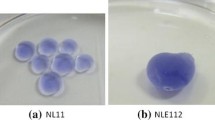Abstract
Polyurethane Bayer was tested as an occlusive agent for experimental embolization in postmortem and postnephrectomy kidneys which served as a tumor model. Coaxial and balloon catheters were used for the embolization. To make polyurethane radiopaque, the material was labeled with different water-soluble, oily and solid contrast agents. Best results were achieved with oily contrast materials, e.g., Pantopaque. We found that polyurethane can easily be injected during a predetermined working time of 8–10 min. The embolization results in a complete, permanent, and homogenous occlusion of the proximal arterial branches and small peripheral vessels.
Similar content being viewed by others
References
Goldstein HM, Medellin H, Beydoun MT, Wallace S, BenMenachem Y, Brachen RB, Johnson DE (1975) Transcatheter embolization of renal cell carcinoma. AJR 123:557–562
Novak D (1980) Coaxial and balloon catheters in tumour embolization. Experimental results and follow-up studies. In: Veiga-Pires JA (ed) Martins de Silva M, Oliva L (co-eds) Intervention radiology pp. 302–308 No. 522 Proceedings of the First International Symposium on Intervention Radiology, Algarve, Portugal, May 29–June 2, 1979. Excerpta Medica, Amsterdam Oxford Princeton.
Berenstein A, Kricheff JJ (1979) Catheter and material selection for transcatheter embolization: Technical considerations. II. Materials. Radiology 132:631–639
Greenfield AJ (1980) Transcatheter vessel occlusion: Selection of methods and materials. Cardiovasc Intervent Radiol 3:222–228
Probst P, Castaneda-Zuniga WR, Gomes HS, Amplatz K (1978) Which embolic material is best suited for which embolization procedure? ROEFO 129:447–454
Novak D, Weber J, Wieners H, Zabel G (1981) New liquid and semiliquid embolizing substances for tumour embolization. An experimental study. Ann Radiol 24:428–431
Doppman JL, Aven W, Bowman RF, Wood LL, Girton M (1978) A rapidly polymerizing polyurethane for transcatheter embolization. Cardiovasc Intervent Radiol 1:109–116
Author information
Authors and Affiliations
Rights and permissions
About this article
Cite this article
Novak, D., Wieners, H. & Rueckner, R. Applicability of liquid radiopaque polyurethane for transcatheter embolization. Cardiovasc Intervent Radiol 6, 133–137 (1983). https://doi.org/10.1007/BF02552764
Issue Date:
DOI: https://doi.org/10.1007/BF02552764




